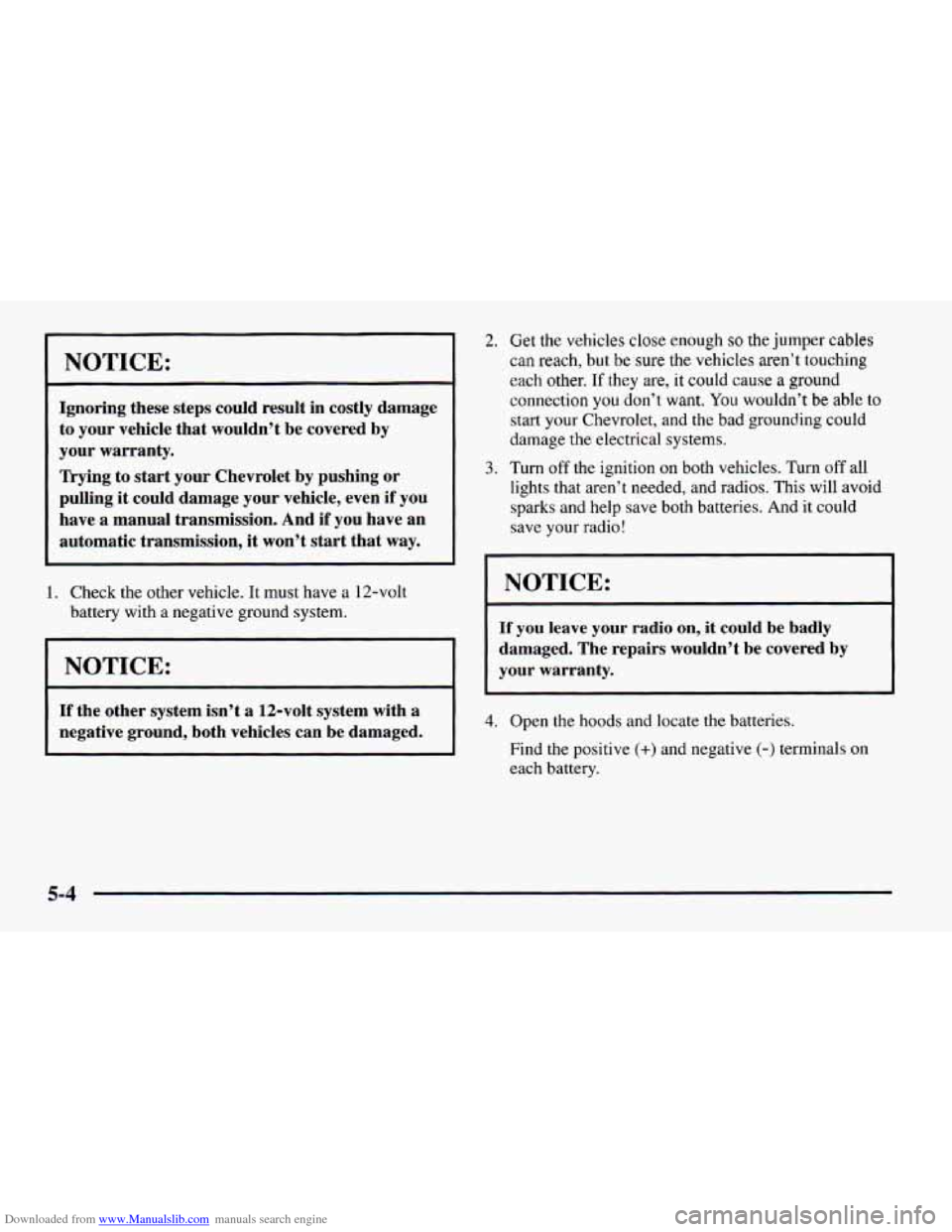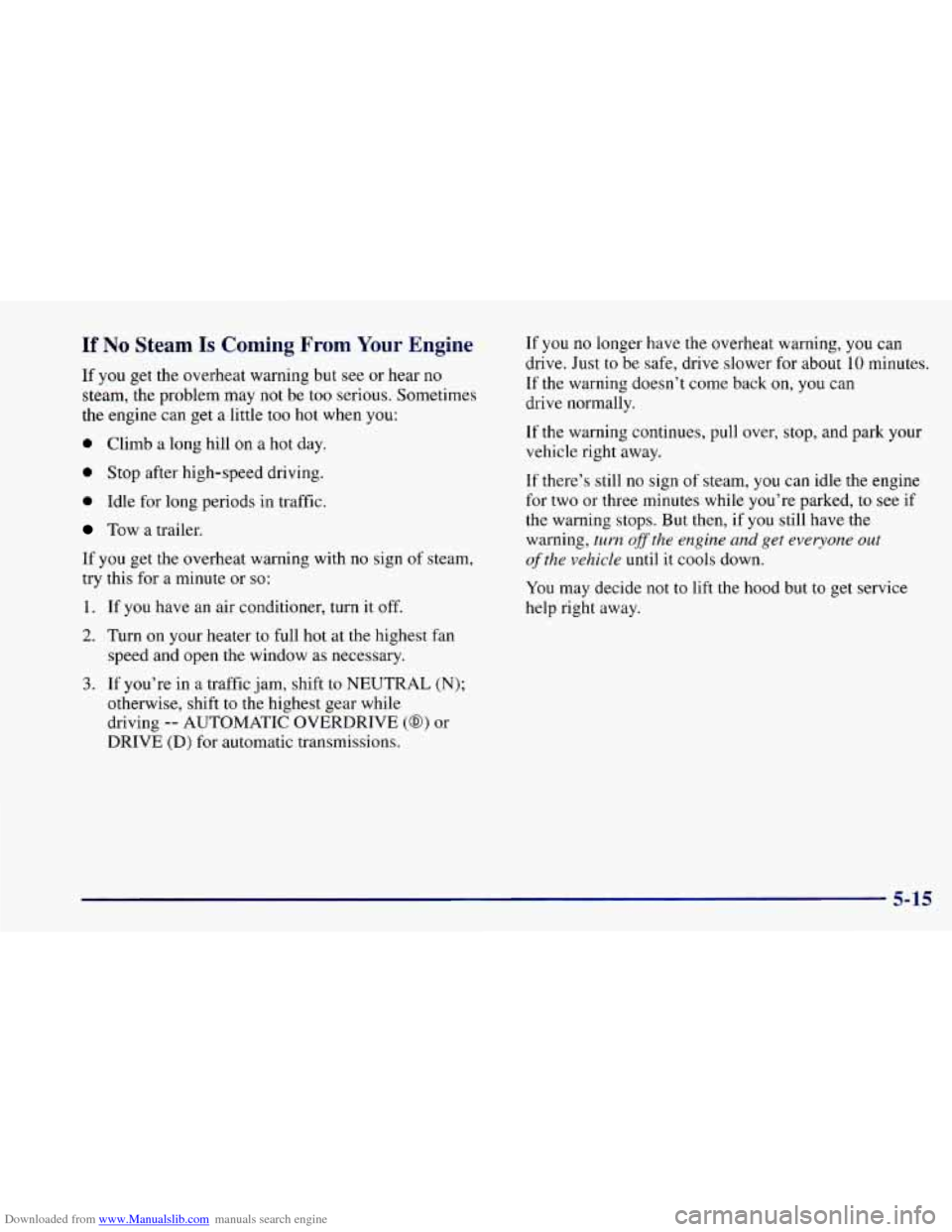Page 78 of 404

Downloaded from www.Manualslib.com manuals search engine To Use the Coolant Heater
1. Turn off the engine.
2. Open the hood and unwrap the electrical cord.
3. Plug it into a normal, grounded 1 10-volt AC outlet.
Plugging the cord into an ungrounded outlet
could cause an electrical shock.
Also, the wrong
kind
of extension cord could overheat and cause
a fire. You could be seriously injured. Plug the
cord
into a properly grounded three-prong
110-volt
AC outlet. If the cord won’t reach, use a
heavy-duty three-prong extension cord rated for
at least
15 amps.
4. Before starting the engine, be sure to unplug and
store the cord as
it was before to keep it away from
hot pipes, manifold or moving engine parts. If you
don’t,
it could be damaged.
How long should
you keep the coolant heater plugged
in? The answer depends
on the outside temperature, the
kind
of oil you have, and some other things. Instead of
trying to list everything here, we ask that you contact
your Chevrolet dealer in the area where you’ll be
parking your vehicle. The dealer can give you the best
advice for that particular area.
2-28
Page 208 of 404

Downloaded from www.Manualslib.com manuals search engine NOTICE:
Ignoring these steps could result in costly damage
to your vehicle that wouldn’t be covered by
your warranty.
Trying to start your Chevrolet by pushing
or
pulling it could damage your vehicle, even if you
have a manual transmission. And if you have an
automatic transmission,
it won’t start that way.
1. Check the other vehicle. It must have a 12-volt
battery with a negative ground system.
NOTICE:
If the other system isn’t a 12-volt system with a
negative ground, both vehicles can be damaged.
2.
3.
Get the vehicles close enough so the jumper cables
can reach, but be sure the vehicles aren’t touching
each
other. If they are, it could cause a ground
connection you don’t want.
You wouldn’t be able to
start
your Chevrolet, and the bad grounding could
damage the electrical systems.
Turn off the ignition
on both vehicles. Turn off all
lights that aren’t needed, and radios. This will avoid
sparks and help save both batteries. And it could
save your radio!
I NOTICE:
If you leave your radio on, it could be badly
damaged. The repairs wouldn’t be covered by
your warranty.
4. Open the hoods and locate the batteries.
Find
the positive (+) and negative (-) terminals on
each battery.
5-4
Page 218 of 404

Downloaded from www.Manualslib.com manuals search engine 'Engine Overheating
You will find a coolant temperature gage on your
Chevrolet's instrument panel. You may also find a LOW
COOLANT warning light on your Chevrolet's
instrument panel.
(V8 Engine Only)
If Steam Is Coming From Your Engine
t A
/! CAUTION:
Steam from an overheated engine can burn
badly, even if you just open the hood. Stay away
from the engine
if you see or hear steam coming
from it. Just turn
it off and get everyone away
from the vehicle until it cools down. Wait until
there
is no sign of steam or coolant before you
open the hood.
If you keep driving when your engine is
overheated, the liquids in it can catch fire. You or
others could be badly burned. Stop your engine
if
it overheats, and get out of the vehicle until the
engine is cool.
I NOTICE:
~~ ~
If your engine catches fire because you keep
driving with no coolant, your vehicle can be
badly damaged. The costly repairs would not be
covered
by your warranty.
5-14
Page 219 of 404

Downloaded from www.Manualslib.com manuals search engine If No Steam Is Coming From Your Engine
If you get the overheat warning but see or hear no
steam, the problem may not be too serious. Sometimes
the engine can get
a little too hot when you:
0 Climb a long hill on a hot day.
0 Stop after high-speed driving.
0 Idle for long periods in traffic.
Tow a trailer.
If
you get the overheat warning with no sign of steam,
try this for a minute or
so:
1. If you have an air conditioner, turn it off.
2. Turn on your heater to full hot at the highest fan
speed and open
the window as necessary.
3. If you’re in a traffic jam, shift to NEUTRAL (N);
otherwise, shift to the highest gear while
driving
-- AUTOMATIC OVERDRIVE (a) or
DRIVE (D) for automatic transmissions.
If you no longer have the overheat warning, you can
drive. Just to be safe, drive slower for about
10 minutes.
If the warning doesn’t come back on, you can
drive normally.
If the warning continues, pull over, stop, and park your
vehicle right away.
If there’s still no sign of steam, you can idle the engine
for two or three minutes while you’re parked,
to see if
the warning stops. But then, if you still have the
warning,
turn ofthe engine and get everyone out
of the vehicle until it cools down.
You may decide not
to lift the hood but to get service
help right away.
5-15
Page 250 of 404

Downloaded from www.Manualslib.com manuals search engine At a minimum, the gasoline you use should meet
specifications ASTM
D4814 in the United States and
CGSB 3.5-M93 in Canada. Improved gasoline
specifications have been developed by the American
Automobile Manufacturers Association (AAMA) for
better vehicle performance and engine protection.
Gasolines meeting the AAMA specification could
provide improved driveability and emission control
system protection compared to other gasolines.
Be
sure the posted octane for premium is at least 9 1
(at least 89 for middle grade and 87 for regular). If the
octane is less than
87, you may get a heavy knocking
noise when you drive.
If it’s bad enough, it can damage
your engine.
If you’re using fuel rated at the recommended octane or
higher and you still hear heavy knocking, your engine
needs service. But don’t worry if you hear a little
pinging noise when you’re accelerating or driving up a
hill. That’s normal, and you don’t have to buy
a higher
octane fuel to get
rid of pinging. It’s the heavy, constant
knock that means you have a problem. If
your vehicle
is certified to meet California Emission
Standards (indicated
on the underhood tune-up label),
it is designed to operate
on fuels that meet California
specifications.
If such fuels are not available in states
adopting California emissions standards, your vehicle
will operate satisfactorily
on fuels meeting federal
specifications, but emission control system performance
may be affected. The malfunction indicator lamp on
your instrument panel may turn
on and/or your vehicle
may fail
a smog-check test. If this occurs, return to your
authorized Chevrolet dealer for diagnosis to determine
the cause of failure. In the event it is determined that the
cause
of the condition is the type of fuels used, repairs
may not be covered by your warranty.
Some gasolines that are not reformulated for low
emissions contain an octane-enhancing additive called
methylcyclopentadienyl manganese tricarbonyl (MMT);
ask your service station operator whether or not his fuel
contains MMT. General Motors does not recommend the
use
of such gasolines. If fuels containing MMT are used,
spark plug life may be reduced and your emission
control system performance may be affected. The
malfunction indicator lamp
on your instrument panel
may turn on. If this occurs, return to your authorized
Chevrolet dealer
for service.
6-4
Page 255 of 404
Downloaded from www.Manualslib.com manuals search engine Hood Release
F
To open the hood, first pull the handle inside the lower
left side of your vehicle.
n
Then go to the front of the vehicle and pull up on the
hood release located
at the center area of the hood.
Lift the hood.
6-9
Page 256 of 404
Downloaded from www.Manualslib.com manuals search engine When you open the hood of the 3800 Engine you'll see:
.. > .. - k
A. Engine Coolant Reservoir
B. Battery
C. Oil Fill Cap
D. Automatic Transmission Dipstick
(If Equipped))
E. Engine Fan I. Brake Fluid Reservoir
F. Windshield Washer Reservoir J. Clutch Fluid Reservoir
G. Power Stee.ring Reservoir (If Equipped))
H. Engine Oil Dipstick K. Air Cleaner
6-10
Page 257 of 404
Downloaded from www.Manualslib.com manuals search engine When you open the hood of the 5.7L Engine you’ll see:
A. Engine Cool ant Res ervoir
B. Power Steering Reservoir
C. Engine
Oil Dipstick
D. Battery
E. Engine Oil Fill Cap
E Automatic Transmission
Dipstick
(If Equipped)
G. Fan
H. Windshield Washer Reservoir
I. Brake Fluid Reservoir
J. Clutch Fluid Reservoir
(If Equipped)
K. Air Cleaner
6-11